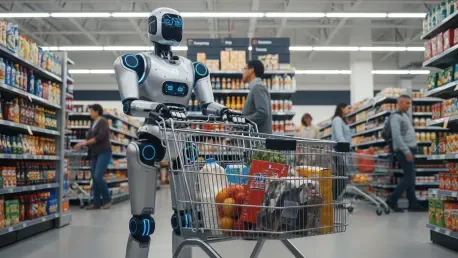I’m thrilled to sit down with Zainab Hussain, a seasoned e-commerce strategist with a wealth of experience in customer engagement and operations management. With a sharp eye on the evolving landscape of digital retail, Zainab offers invaluable insights into how grocery chains are leveraging technology and loyalty programs to drive growth. Today, we’re diving into the impressive performance of a major grocery retailer in their second quarter, exploring their digital sales surge, innovative AI tools, and strategic approaches to customer loyalty and fulfillment. Our conversation touches on the power of personalized shopping experiences, the impact of store proximity on e-commerce, and the future of retail media networks in enhancing customer value.
How have digital sales trends shaped the grocery industry recently, and what stands out about achieving a 23% year-over-year increase in this area?
The grocery industry has seen a massive shift toward digital channels, especially post-pandemic, as customers prioritize convenience and speed. A 23% year-over-year increase is significant—it reflects not just a growing customer base but also deeper engagement through digital platforms. This kind of growth often comes from a mix of seamless user experiences on mobile apps, targeted promotions, and robust fulfillment options like pickup and delivery. It’s a sign that the retailer is meeting customers where they are, whether that’s through an app or a quick online order, and making the process frictionless.
What do you think are the key digital tools or platforms that can drive such consistent e-commerce growth, especially at a 24% compounded annual rate over several years?
Consistency at that level—24% compounded annually—points to a strong foundation in mobile app functionality and data-driven personalization. Tools like integrated apps that handle everything from meal planning to shopping lists are game-changers. Additionally, leveraging customer data to offer tailored recommendations or promotions keeps users coming back. I’d also highlight the role of partnerships with delivery services and investments in user-friendly interfaces that make online shopping as intuitive as walking through a store aisle. It’s about reducing barriers and enhancing every touchpoint.
Turning to loyalty programs, how can a membership base of over 48 million with a 13% growth impact overall business performance?
A loyalty program of that scale—48 million members with double-digit growth—is a goldmine for both revenue and insights. It drives repeat purchases because members feel valued through rewards and personalized offers, which directly boosts sales frequency and basket size. Beyond that, the data collected from these members fuels better marketing strategies and product decisions. It’s a virtuous cycle: engaged customers spend more, and their behavior informs how to keep them engaged. This kind of growth also suggests successful acquisition strategies, likely through digital sign-ups and in-store incentives.
Can you elaborate on why immediate rewards, like a cash-off option chosen by nearly 40% of engaged households, resonate so strongly with customers?
Immediate rewards like cash-off options tap into a basic human desire for instant gratification. When 40% of households opt for this, it shows that tangible, right-now value often trumps delayed benefits like points for future use. In today’s economy, where budgets are tight for many, getting a direct discount on a current purchase feels like a win. It builds trust in the program—customers see the benefit immediately, which encourages them to keep engaging. It’s a smart move for retailers to offer this, as it reinforces loyalty without a long wait for payoff.
How does a store-based fulfillment model provide a competitive edge over online-only players in the grocery space?
Store-based fulfillment is a huge advantage because it leverages existing infrastructure—physical stores close to customers’ homes. Unlike online-only competitors, this model offers unmatched proximity, which translates to faster delivery or pickup options like Drive Up & Go. It also ensures fresher products since items are pulled directly from store shelves, not distant warehouses. Plus, it allows for flexibility; customers can choose between in-store shopping or online orders without the retailer needing separate supply chains. This closeness to the community creates a trust factor that purely digital players struggle to replicate.
Speaking of innovations, how do AI features like conversational search tools enhance the shopping experience for customers?
Conversational AI tools are transforming how customers interact with grocery platforms by making the experience intuitive and personal. Instead of browsing endless categories, a customer can simply ask for ideas—like healthy snacks for kids—and get tailored suggestions instantly. It mimics a helpful store associate but with the added power of data-driven personalization, pulling from past purchases or preferences. This kind of tech speeds up decision-making, builds smarter baskets, and often introduces customers to new products through cross-category discovery, enhancing both convenience and engagement.
How are AI agents being utilized beyond customer-facing tools to improve other aspects of retail operations?
AI agents are incredibly versatile in retail operations, going far beyond customer interactions. They’re used in pricing strategies to analyze competitor data and demand trends in real-time, ensuring competitive yet profitable pricing. In promotions, AI can predict which offers will resonate with specific customer segments, maximizing impact. For customer care, these agents handle inquiries or issues swiftly through chatbots, freeing up human resources. They also optimize inventory by forecasting demand, reducing waste—especially critical for perishable goods. It’s about embedding intelligence into every layer of the business.
What potential do you see in partnerships with advanced AI technologies for shaping merchandising intelligence in retail?
Partnerships with cutting-edge AI technologies open up exciting possibilities for merchandising intelligence. They enable retailers to process vast amounts of data—think sales trends, customer preferences, and even external factors like weather—to make smarter decisions about what to stock, where, and when. Agentic AI can automate and refine product placement strategies, predict seasonal demands, and even suggest bundling opportunities that drive higher sales. It’s about moving from reactive to proactive merchandising, ensuring shelves and online catalogs are always aligned with what customers want before they even ask.
Looking at retail media networks, how do strategies like shoppable recipes or connected TV contribute to a stronger customer value proposition?
Retail media networks are redefining how grocery chains connect with customers by blending advertising with utility. Shoppable recipes, for instance, turn inspiration into action—customers see a meal idea and can add ingredients to their cart with one click, enhancing convenience. Connected TV extends reach by delivering targeted ads during streaming, often tied to loyalty data for relevance. These strategies, along with in-store digital signage, create a seamless journey from awareness to purchase. They also add value through personalized promotions and competitive pricing, making customers feel understood while driving incremental sales for advertisers.
What is your forecast for the role of AI and digital platforms in the future of grocery retail?
I see AI and digital platforms becoming even more central to grocery retail over the next decade. AI will likely evolve to anticipate customer needs with uncanny precision—think predictive shopping lists or automated reordering for staples before you run out. Digital platforms will further blur the lines between online and in-store experiences, creating a truly omnichannel ecosystem where every interaction is personalized. We’ll also see deeper integration of retail media with AI, offering hyper-targeted ads that feel less like marketing and more like helpful suggestions. The focus will be on efficiency for retailers and effortless convenience for customers, reshaping how we think about grocery shopping entirely.









